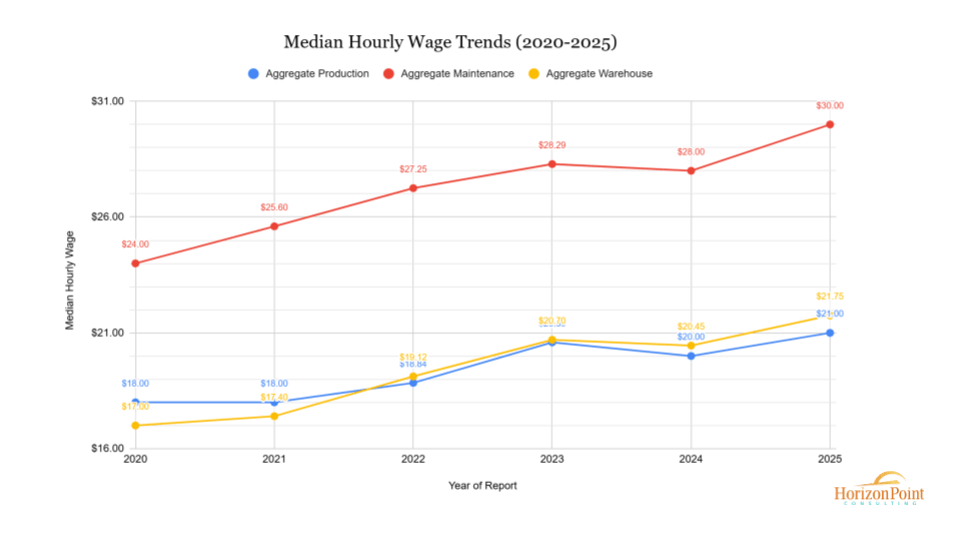The 2025 North Alabama Wage and Benefit Survey, conducted by Horizon Point Consulting and hosted by NAIDA, North AlabamaWorks!, NARCOG, NACOLG, and seven participating counties, gives employers in our region valuable insight into compensation, workforce practices, and benefits.
With input from 152 participating organizations—including 81 manufacturers and 50 government contractors—this year’s report shows how pay and perk strategies are evolving across North Alabama.
Who Took the Survey?
Employers across diverse sectors contributed:
- 152 total participants
- 81 manufacturers
- 50 government contractors
- Representing Colbert, Cullman, Lauderdale, Lawrence, Limestone, Madison, and Morgan counties
Hard-to-Fill Jobs
Respondents identified persistent hiring challenges in:
- Skilled trades and technicians, especially for off-hours and specialized roles
- Engineering and IT
- Finance, HR, and leadership
- Production, warehousing, and frontline service roles
- Education and hospitality support
Pay Practices and Compensation Trends
- Average last pay increase: 4.11%
- Median last pay increase: 3.35%
- Average next pay increase planned: 3.48%
- Median next pay increase: 3.00%
- Turnover: Down 16% from 2023—an encouraging trend across most industries
Wage comparisons reveal moderate increases:
- Accounting clerks: $23.00 to $24.48/hour
- Customer service reps: $20.25 to $21.48/hour
- HR assistants: $57,000 to $60,000/year
- Production roles: $20.78 to $21.91/hour
- Maintenance: $27.39 to $28.90/hour
- Warehouse/logistics: $20.52 to $21.39/hour
Some employers are adopting skills-based pay programs, offering:
- $1.00/hour for learning additional skills
- Maintenance progression increases of up to $5/hour based on testing and training
- Pay raises tied to performance on a skills matrix
Emerging Scheduling Trends
A few employers are exploring non-traditional shift models:
- Short shifts (3–8 p.m. options)
- 8-hour formats instead of traditional 12-hour shifts
- Part-time based on availability and business needs
Benefits Overview
- Average total benefit cost per employee: $14,098.61 (up 9.4%)
- Individual medical coverage (median): $7,524.79 (up 15.8%)
- Family medical coverage (median): $20,308.56 (up 18%)
Non-Traditional Benefits Employers Are Offering
In addition to traditional benefits, many employers are getting creative with their perks. Survey responses show a growing focus on holistic employee well-being, including:
- Wellness Reimbursement Plans to cover the cost of fitness and personal health equipment
- Charitable Gifts Matching to support employees’ financial support of community nonprofits, giving directly to organizations with personal meaning to internal staff
- Employee Stock Ownership Plan (ESOPs) increased this year, continuing the trend of giving employees more direct ownership in the success of the company.
These nontraditional offerings help employers stand out and signal a commitment to supporting employees beyond the basics.
Paid Leave, Child Care, and Wellness Support
31% of participating companies are offering Paid Family Leave for new parents after the birth or adoption of a child. The average leave time is 7 weeks, and 87% of participating employers pay a full 100% of salary. These stats are up from 2024.
13% of employers offer some type of Child Care benefit, primarily by offering an FSA or vouchers to nearby child care centers. This is up a bit from 2024.
53% of employers offer Remote/Telework employment options, most in a hybrid format. Additionally, 35% of employers offer Flex-Time, allowing employees to work alternate hours to accommodate child care and other needs.
State-Funded Workforce Programs, Tax Incentives, and Child Care Credits
- AIDT used by 18% of employers
- Alabama Office of Apprenticeship: 15% of participants offer registered apprenticeships
- Existing Industry Training Program (EITP): only utilized by 4% of respondents with an additional 5% considering applying.
- Alabama’s Employer Tax Credit for Child Care is also gaining attention. It offers:
- Up to $15 million in statewide tax credits in 2025, $17.5 million in 2026, and $20 million in 2027.
- Small Businesses (fewer than 25 employees): Eligible for a credit equal to 100 percent of eligible expenses, with a maximum of $600,000 annually.
- Other Employers (25 or more employees): Eligible for a credit equal to 75 percent of eligible expenses, with a maximum of $600,000 annually.
However, only 1% of participants in this year’s survey have applied for the Child Care credit so far, and 53% do not intend to apply at all.
Why This Survey Matters
With rising costs, shifting workforce expectations, and the competitive labor market, the 2025 North Alabama Wage and Benefit Survey provides critical benchmarks. It equips organizations with:
- Reliable data for budgeting and planning
- Insight into regional labor market pressures
- A roadmap for strategic compensation and benefit design
To learn more, access the full interactive survey reports via Sensible Surveys or contact the Horizon Point team for consultation and support.





